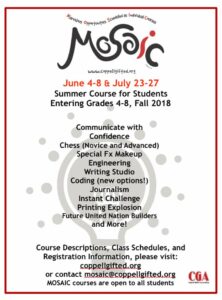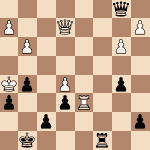Teaching chess to groups can be tricky, as not everyone comes to class with the same background knowledge. In How to teach chess (part one), I shared lesson plans for two 1.5 hour sessions with a mixed group (absolute beginners in the same class with chess players with some experience). In this article, I share lesson plans for three more 1.5 hour sessions with mixed groups of students ages 8-13.

The lesson plans in this article and in my previous article are from classes I taught June 4-8, 2018, at MOSAIC, run by the Coppell Gifted Association. In June, I taught chess to a mixed group of 10 children from 9:00 a.m. to 10:30 a.m. and then taught a different mixed group of 10 children from 10:30 a.m. to noon during the Monday through Friday week. I am teaching chess again at MOSAIC from July 23-27. I plan to repeat my lesson plans from June for my 10:30 to noon July Chess class, which will again be a mixed group of beginners combined with those with some chess experience. My 9:00-10:30 a.m. “Chess-Advanced” class in July will be composed of students who either have previously had me as an instructor or who have a chess rating from the US Chess Federation or from FIDE (World Chess Federation). For that advanced class, I will teach more advanced topics such as the Philidor’s position.
Returning to my summary of the June 4-8 lesson plans for mixed groups, I begin with my lesson plan for Wednesday (as my previous article detailed what I taught on Monday and Tuesday). On Wednesday, leftover tournament games from Tuesday were completed by some students. Students without adjourned games to play off were tested by me on drills (such as the two-rook checkmate, the one-queen checkmate, or the one-rook checkmate), practiced for those tests, or played the Pawn Game or Battleship Chess. Then I taught how to castle, using the demonstration board and notating on the dry erase board next to the demonstration board. For some students, both the rules for castling and how to write notation were new. Then I taught the Game Theory challenge from Thinking With Chess: Teaching Children Ages 5-14. In that challenge, whichever side castles kingside first wins. The games, usually five moves long, have to be notated. After each partner has played White once, the challenge changes to whoever castles queenside first wins. For the last half hour of the 1.5-hour-long class, I paired the children for round 3 of a four-round Swiss system tournament. As taught in Science, Math, Checkmate: 32 Chess Activities for Inquiry and Problem Solving, children made diagrams for games that had to be adjourned for the next class. At dismissal time, I told the children to practice their drills (such as the two-rook checkmate or one-queen checkmate) at home, by viewing instructional online videos or by practicing the drills with a computer opponent or a family member.
On Thursday, leftover tournament games from Wednesday were completed by some students. Students without adjourned games to play off tested on drills, practiced for those tests, or played the Pawn Game or Battleship Chess. Then I taught the Create challenge from Thinking With Chess: Teaching Children Ages 5-14. I began by teaching the en passant (e.p.) rule, writing notation from a Pawn Game that included e.p. captures on the dry erase board while simultaneously showing the moves on a demonstration board. Then pairs of children cooperated to create and notate their own Pawn Games, which had to be 10 moves or less and had to include three e.p. captures. I checked each pair’s work by using their score sheets to replay the game. For the last half hour of the 1.5-hour-long class, I paired the children for round 4 of a four-round Swiss system tournament. Children made diagrams for games that had to be adjourned for the next class. At dismissal time, I reminded the children to practice their drills.
On Friday, leftover tournament games from Thursday were completed by some students. Students without adjourned games to play off tested on drills, practiced for those tests, or played the Pawn Game or Battleship Chess. Then I taught the Criteria Challenge activity from Science, Math, Checkmate: 32 Chess Activities for Inquiry and Problem Solving. This activity is based on an exercise in the Comprehensive Chess Course Volumes I and II by Roman Pelts and Grandmaster Lev Alburt. Pelts and Alburt listed certain material and asked readers to create either a checkmate or a stalemate. My favorite is this one: White has a king and a bishop, Black has a king, bishop, and pawn. Can you create a position where Black (who is to move) is stalemated? If so, share your answer in the comments! The final activity was my giving a simultaneous chess exhibition against my students. Students had to notate their games with me, and parents could offer advice to their students on their games. Many parents were impressed that their children, some of whom knew nothing about chess on Monday, could play and notate a chess game on Friday. The simultaneous exhibition began 45 minutes before the class ended. I checkmated several students but other students survived (though down material) until the end of class.
